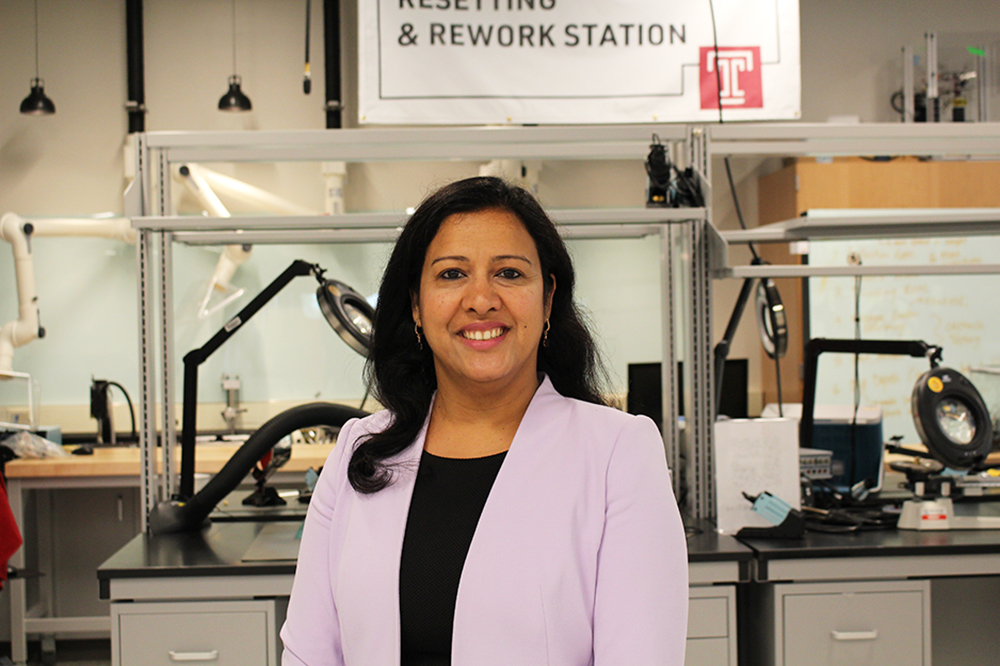With the Spring 2023 semester under her belt, Associate Professor of Bioengineering, Dr. Anita Singh, is bringing her dedication to students and passion for her research to her first full academic year as a professor at Temple University.
After just one semester, when asked what she enjoys most about Temple, Singh immediately says she “loves the students.” When she learned her first class would be an 8 AM course, Singh explains “[I] went in with the fear I may not be able to get them to talk back to me when I asked questions, but it was an absolute pleasure...the students have been an absolute pleasure.”
Hearing insightful questions from students and being thrilled with their willingness to work through material vanquished any nerves Singh may have had.
Supporting students’ academic development and getting them involved in hands-on research early in their academic career is incredibly important to Singh. Outside of teaching, she assists with organizing an undergraduate design competition at the Summer Biomechanics, Bioengineering, and Biotransport Conference (SB3C). She describes the purpose of this competition as “instilling the mindset into undergraduates of creating solutions that are applicable and meet clinical needs.”
Singh extends this mindset to her own lab, involving students, both graduate and undergraduate, in all aspects of research, and even hosted high school students as part of the College of Engineering’s partnership with Heights Philadelphia, in which students come into cutting-edge research labs and complete field-style projects as part of a summer program.
Her research focuses on neonatal brachial plexus injury that might occur during complicated birthing scenarios. During childbirth “if a baby is stuck past 90 seconds, that is considered complicated delivery,” explains Singh. Complicated deliveries can lead to brachial plexus injuries, in which the brachial plexus nerves that control from the shoulder all the way down through arm to the fingers, connected to the spinal cord, are damaged due to overstretching.
Singh and her team take data gathered from simulated injuries in large animal models, collaborate with experts from Shriner’s Hospital to translate the animal data findings to a human clinic, and then create computational mathematical models to simulate similar birthing scenarios. Computational models are then studied, and ideally used as a tool in minimizing these birthing injuries.
Singh was previously awarded an NSF (National Science Foundation) Career Grant that partnered her with two global clinicians in India who review these models, provide feedback, and help make the model more human-like. In turn, the clinicians also assist Singh in modifying her experimental methods, as they provide insight into more common injuries they see in clinic and surgical settings.
Another focus of her research, funded by a $1.9 million grant from the National Institute of Health, involves the use of bodily fluids to test for injury biomarkers. Singh explains patients are “typically waiting three to six months to confirm [birthing] injuries.” Testing for presence of these injury biomarkers would be done immediately after a complicated delivery, allowing for early intervention in treatment.
As she starts her second semester teaching at Temple, Singh is already looking to the future impact she can have at the College of Engineering and on student learning. She is excited about working towards the creation of simulation labs at Temple that would allow biomedical engineering students to work alongside healthcare professionals, providing cross-disciplinary experience for students. She has also been experimenting with the implementation of virtual reality to allow undergraduate students to virtually experience being in a lab before physically setting foot in one.
With over 13 years of teaching experience and over two decades in the bioengineering field, an NSF Career Award, and Chair of the 2022 Bio Medical Engineering Society Annual Meeting, Dr. Singh brings a plethora of experience to the College of Engineering.
She brings her passion for research and student education to every interaction with faculty, staff, and students, and looks forward to continuing her work in the bioengineering department.

